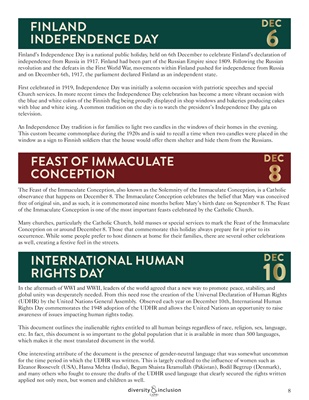
FEAST OF IMMACULATE
CONCEPTION
INTERNATIONAL HUMAN
RIGHTS DAY
FINLAND
INDEPENDENCE DAY
Finland's Independence Day is a national public holiday, held on 6th December to celebrate Finland's declaration of
independence from Russia in 1917. Finland had been part of the Russian Empire since 1809. Following the Russian
revolution and the defeats in the First World War, movements within Finland pushed for independence from Russia
and on December 6th, 1917, the parliament declared Finland as an independent state.
First celebrated in 1919, Independence Day was initially a solemn occasion with patriotic speeches and special
Church services. In more recent times the Independence Day celebration has become a more vibrant occasion with
the blue and white colors of the Finnish flag being proudly displayed in shop windows and bakeries producing cakes
with blue and white icing. A common tradition on the day is to watch the president's Independence Day gala on
television.
An Independence Day tradition is for families to light two candles in the windows of their homes in the evening.
This custom became commonplace during the 1920s and is said to recall a time when two candles were placed in the
window as a sign to Finnish soldiers that the house would offer them shelter and hide them from the Russians.
The Feast of the Immaculate Conception, also known as the Solemnity of the Immaculate Conception, is a Catholic
observance that happens on December 8. The Immaculate Conception celebrates the belief that Mary was conceived
free of original sin, and as such, it is commemorated nine months before Mary's birth date on September 8. The Feast
of the Immaculate Conception is one of the most important feasts celebrated by the Catholic Church.
Many churches, particularly the Catholic Church, hold masses or special services to mark the Feast of the Immaculate
Conception on or around December 8. Those that commemorate this holiday always prepare for it prior to its
occurrence. While some people prefer to host dinners at home for their families, there are several other celebrations
as well, creating a festive feel in the streets.
In the aftermath of WWI and WWII, leaders of the world agreed that a new way to promote peace, stability, and
global unity was desperately needed. From this need rose the creation of the Universal Declaration of Human Rights
(UDHR) by the United Nations General Assembly. Observed each year on December 10th, International Human
Rights Day commemorates the 1948 adoption of the UDHR and allows the United Nations an opportunity to raise
awareness of issues impacting human rights today.
This document outlines the inalienable rights entitled to all human beings regardless of race, religion, sex, language,
etc. In fact, this document is so important to the global population that it is available in more than 500 languages,
which makes it the most translated document in the world.
One interesting attribute of the document is the presence of gender-neutral language that was somewhat uncommon
for the time period in which the UDHR was written. This is largely credited to the influence of women such as
Eleanor Roosevelt (USA), Hansa Mehta (India), Begum Shaista Ikramullah (Pakistan), Bodil Begtrup (Denmark),
and many others who fought to ensure the drafts of the UDHR used language that clearly secured the rights written
applied not only men, but women and children as well.
DEC
DEC
DEC
6
8
106